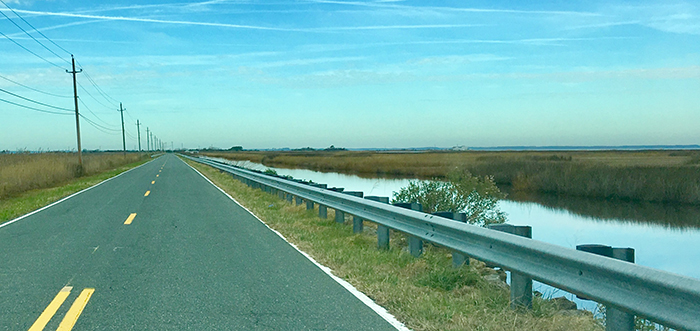Saxis, Michael Marsh and Freeschool Marsh Wildlife Management Area; Makemie Monument
IN BRIEF: A huge area of saltmarsh habitat, once home to a few dozen Black Rails, still of interest for marsh sparrows, owls, and occasional wintering Rough-legged Hawk. Bird and deer hunting occurs sporadically in April, May, September, October, November, December, January, and February. Wearing blaze orange in those months is advisable.
ACCESS: Limited to roadside birding (take precautions), kayak exploration, and boat tours. No permit is required for those birding from the roadsides or from water.
Telephone: 804-829-6580 (Virginia Department of Game and Inland Fisheries)
Additional Info: Virginia DGIF Birding Trail Site
Saxis, Michael Marsh and Freeschool Marsh Wildlife Management Area;
Makemie Monument
Saxis Wildlife Management Area protects about 5678 acres of tidal saltmarsh habitat, most of which is not accessible to the public on foot or by car (see Boat Tours section). This area is legendary among birders for its small population of Black Rails and Henslow’s Sparrows, but sadly, the last rail was heard here in 2014, the last sparrow in 2001. Saxis can still be a good place to hear and see the scarce Saltmarsh Sparrow, as well as other marsh birds, and so it is still occasionally visited. Typical marsh and mudflat birds, including herons and allies and a few shorebirds, are expected year round.
There are three divisions in this management area. Freeschool Marsh lies east of the village of Saxis and west of Sanford. Michael Marsh lies to the southwest of that area, on a short peninsula between Messongo Creek and Beasley Bay. Guard Shore, well to the south, is found at the end of Guard Shore Road. Birders have historically only visited Freeschool Marsh, which is bisected by Route 695, the road to the village of Saxis. Along this road, typically before the first structure is reached on the north side of the road, Saltmarsh Sparrows can be heard on calm evenings, among a din of singing Marsh Wrens and Seaside Sparrows (and mosquitoes). A spur road, Hammock Road (Route 788), sometimes has the species but less often (it was here that the last Black Rails and Henslow’s Sparrows held on). One advantage to the spur road is that it has much less traffic than Route 695, and so it can be an optimal place to look and listen for birds. On the edges of marshes, narrow hummocks rise slightly, permitting lines of small Loblolly Pine to intrude here and there, which provide toeholds for nesting Brown-headed Nuthatch, Eastern Screech-Owl, Great Horned Owl, and Chuck-will’s-widow; the occasional Eastern Whip-poor-will heard here is likely to be a migrant rather than a nester.
Herring Gulls.
In winter, Rough-legged Hawks and Short-eared Owls (rarely Barn Owls) can occasionally be seen foraging over the huge marsh area from just about any vantage, but Hammock Road provides a view to the west, with a large expanse of marsh and the afterglow of the sunset, helpful for detecting silhouettes of owls. In spring, a night spent listening to the sky overhead can produce a great variety of migrants. King Rail, Scarlet Tanager, Upland Sandpiper, Black-billed Cuckoo, and Gray-cheeked Thrush have been heard passing overhead here in early May by those holding vigils for Black Rail. Barn Owls do nest in two or three locations locally, so listen for their cries at night as well.
Toward the town of Saxis proper, there are a few opportunities to look toward Pocomoke Sound (mostly in Maryland), where at least sometimes in winter there are rafts of Canvasbacks, Redheads, and Greater and Lesser Scaup, along with many other waterfowl species. Canvasback is otherwise quite scarce in the lower parts of the bay, which has lost much of its submerged aquatic vegetation in recent decades, though efforts to restore it are underway. Any vantage point overlooking the bay can produce interesting records of water birds, and migration of loons, grebes, jaegers, and the like has never been studied here.
The Guard Shore section of the Saxis Wildlife Management Area is rarely visited by birders. It offers the promise of less traffic, as there is only a tiny beach (100 yards long at most) at the end of the road. (Weekend nights are likely to have some night joyriders out, as along Route 695.) Black Rail has been reported here but has not been verified in the twenty-first century. Hopefully, one will reappear. The marsh here is similar to Freeschool but is smaller; strategies for birding would be identical. For those pining to hear a Black Rail at night in April or May, a mosquito suit would be a worthwhile investment. Gladding Landing Road ends at Byrd’s Marsh; a Black Rail was recorded there in April 2014.
A worthy stop on the road into Saxis (695) from Route 13 is Francis Makemie Monument Park, just outside of Sanford, Virginia (approximately 4 miles from Route 13). This small park is created on a parcel where the historic founder of the Presbyterian Church in America, Francis Makemie, purportedly lived and was buried. Though privately owned by the Francis Makemie Society, the park is open to the public from dawn to dusk and provides a small waterfront viewing area on Holdens Creek as well as a small freshwater wetland, fields and woodlands. Brown-headed nuthatch is reliably found here, along with other typical species for the loblolly pine ecosystem.


